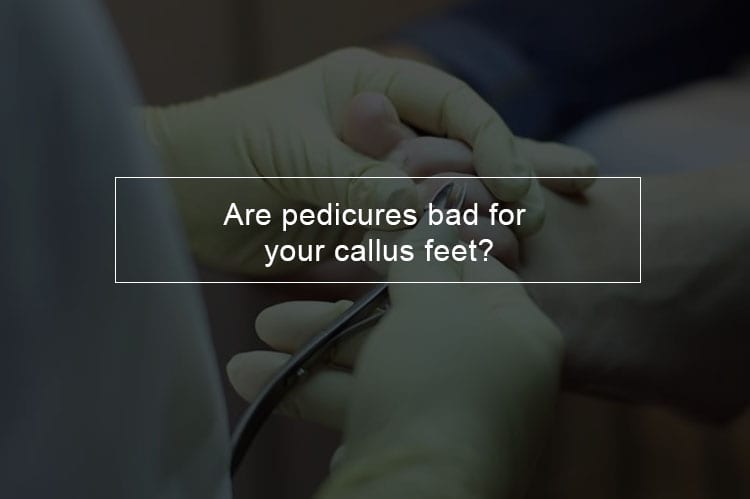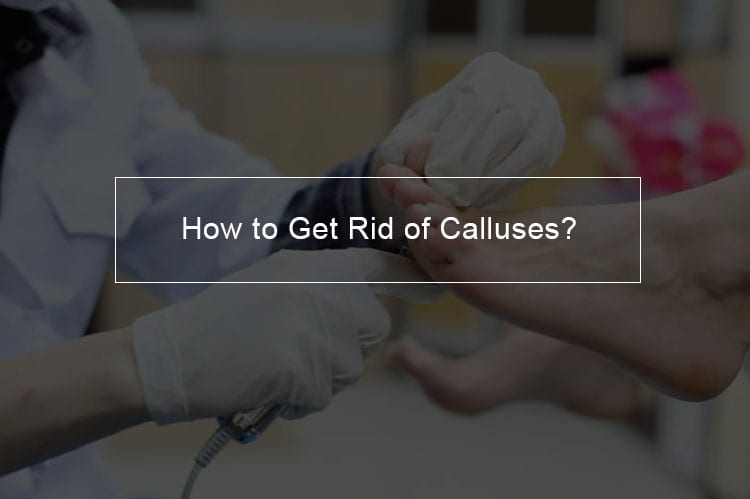
Many salons will attempt and talk you into callus removal, as it is usually an additional service and charge, but is it essential and what does it do to your foot callus. Read more of this article to find out if that pedicure is good or worse for your feet.
Do pedicures make feet worse?
Is pedicure callus remover good for my foot?
When a region of your skin is getting a lot of use and could be vulnerable to blisters, it develops a callus to protect itself. Removing that callus it only makes the skin to become thicker, harder and dryer. Pedicure for the foot or using a foot file will only damage it than make it good. Your feet could feel baby smooth for a few days, but it is not going to be short term.
Worse, while you are doing a pedicure, the only indication you have as a stopping point is a pain. Most people feel their feet are more tender after removing callus, and it is effortless to take off enough skin to draw blood. This opens you up to a lot of problems inclusive of infection. As well as the damage you can do if you are using a metal file on dry skin and not even a callus area.
What you should do for callus feet, is carefully smooth them and then moisturize them. You should then evaluate your leg. If your feet are in a bad condition, consider spending time giving them the needed attention. You might also consider using an electric smoother to take care of the callus. Smooth down any callus using a scrub to remove any dry skin., then moisturize it thoroughly. Make the foot lotion a regular part of your daily routine.
You may also use a pumice rock, to keep your feet check. Scrub your legs with the pumice regularly. Scrub your feet while in the bathroom and apply a foot cream. By the end of the day, the cream will be absorbed fully and will not sag into the sheets while you sleep.
Bottom of feet burning after pedicure
Use of blade in cutting skin during a pedicure to scrape dead skin from the soles of the feet can easily scrape healthy skin causing an injury to the soles of the feet. Though a blade saves time, if an individual endures even the smallest nick from the blade, bacteria can invade their body when the nail tech cleans their feet in the tub water, causing burning of the bottom of the feet after the pedicure.
Even more dangerous is the bacteria remaining in the tub filters which may not be sufficiently disinfected on busy days. In addition, though a new blade is used for every individual, the tool in which each blade sits is not disinfected but is usually reused repeatedly posing a probability of contamination and severe infection.
Sores resulting from a pedicure are made the feet throb and burn. They may also appear red and raw looking wherever they have been scraped by the blade if this happens to see a podiatrist or dermatologist for treatment. A doctor can prescribe ice packs, ibuprofen, and a steroid ointment to reduce the inflammation. A sore resulting from pedicure can take three to four weeks to heal. Patients are not usually admitted, but they are recommended for follow up visits. If must have a pedicure, decline the use of a blade to scrape the soles of your feet.
Sore feet after callus removal
Occasionally, the pressure of the corn or callus may cause inflammation, which could result in pain, swelling, soreness, and redness. However, if the soreness occurs after the callus was removed, it is essential to see a doctor, as this could be a possible sign of infection.
Callus Remover

Depending on your lifestyle, having callused feet can come with advantages. However, many of us, especially during sandal season, opt for smooth heels. This is where most of the callus removers come into play, gadgets that will soften your feet and make you more comfortable to go barefoot. Callus treatment usually involves avoiding the repetitive actions which caused the callus to form. You can help resolve a callus by wearing well-fitting shoes, using protective pads and taking other self-care measures.
There are many different options to treat callused feet: ranging from buffers, pumice stones, and powerful electric motors. There's also a fine line between a gadget that does not remove enough skin and one that removes too much —especially since calluses can be a good thing, particularly for runners. This hardened tissue forms to protect the tender skin from the weight of your body against the ground or friction from your shoes. Tools that are too aggressive will remove that protective layer and make the skin more prone to sensitivity, which can cause the calluses to grow back thicker. Of course, the flip side of this conundrum is an ineffective tool: when calluses become incredibly dense, the skin breaks, exposing the body to infection and discomfort.
Tools for Callus Removal
Electric callus remover
Designed with a powerful motor electric callus, the remover is a great way to remove dead skin and treat callus rapidly. The remover is usually designed with a rechargeable battery that runs continuously for a while, but you will not need to use it that long as it works quite rapidly.
Natural pumice stone
A pumice stone will only remove the tissue you don't need, leaving just the necessary layer of protective skin behind. This is a great, eco-friendly option for runners or people that are naturally prone to calluses.
Foot mask for callus
Do not be afraid to try a foot mask for removing calluses. The most callus foot mask is made from vegetable and leaf extracts that bring long-lasting moisture to coarse, dead skin. The foot mask is also formulated with antibacterial ingredients that keep the affected area clean and supple; each mask can be adjusted to fit your size. You can conveniently wear foot mask underneath socks if you so wish, or wear them alone. Even though the foot mask can take up to two weeks to get rid of the callus completely. There are various flavors of foot callus to choose from- lavender, coconut, rose, and lemon, to mention a few.
If a callus persists or becomes painful despite your self-care efforts, medical treatments can provide relief.
- A doctor can trim excess skin of callus using a scalpel
- A doctor can use salicylic acid to remove a callus. The doctor will tell you how many times to replace the salicylic acid patch. The doctor may also recommend the use of pumice stone to smooth away dead skin.
- If there is any underlying foot deformity, a doctor could prescribe custom-made padded shoe inserts to prevent recurring calluses.
- In scarce instances, surgery may be commended to correct the alignment of a bone causing friction.
Tips for getting pedicure callus removal at the salon
The following practices will help to ensure your pedicure for callus removal is effective and does not result in any challenges.
1. Avoid shaving your legs less than 24 hours before going to the salon. The same goes for the beach.
2. Ask to see the cleaning lo9gs for the whirlpool foot baths and visually inspect them for cleanliness.
3. Do not have a pedicure if you have any sores or cuts on your feet.
4. Ask to see the labels for every product used on your feet. Do refuse to use any non-labeled bottles.
5. To ensure the products are safe to bring your products.
6. Carry your nail polish- sometimes the salons or beauty parlors water polish down and if the polish was used on infected nails, the bacteria can be in the polish bottle and can be transferred to you.
7. Request to examine the instructions for callus remover to make sure it isn’t any longer than it should be.
8. It is okay to skip the callus remover
Can a pedicure get rid of calluses?
DIY pedicure callus removal at home
As discussed above, salon pedicure may not be as safe as they appear. Thus, it is easier to do your pedicure at home, where you can trust your products. The best part is it is inexpensive, and you can do it anytime whether you have a callus or not.
Ingredients for callus removal pedicure:
- Listerine Mouthwash
- White apple cider vinegar
- Warm water
- A basin or a small tub big enough to accommodate your feet
- A pumice stone
The portion you will use:
- Half cup Listerine
- Half cup of white vinegar
- One cup of warm water
Follow the instructions below
Step 1: Mix ingredients in a shallow pan or basin
Step 2: Soak your feet for about fifteen minutes
Step 3: Use a brush or pumice to rub the dead skin right off
Step 4: Apply lotion to moisturize
Note that the blue Listerine will turn your feet blue, but it will come right off in the shower.
Other home remedies to remove callus
If you have diabetes or any other illness that can cause reduced blood flow, consult your doctor before treating an ear of corn and callus on your own. If you do not have any of the following health conditions, you can use any of the suggestions below to remove a callus.
1. Use over the counter pads to protect the area where a callus developed. Be cautious using over the counter liquid callus remover or medicated callus pads. They contain salicylic acid, which could irritate healthy skin and lead to infection, especially in people who have diabetes or other conditions that can cause reduced blood flow.
2. Soak your hands or feet with the callus in warm water; soapy water softens calluses. Soaking the callus in warm water helps to remove the thickened skin.
3. Rub the callus with a pumice stone, nail file or washcloth to help remove a layer of toughened skin. Avoid using a sharp object to trim the skin. Do not use the pumice stone if you have diabetes.
4. Apply moisturizer on the callus, hands, and feet to keep the skin soft.
5. Wear comfortable shoes and socks to manage and treat callus. Stick to well fitting cushioned shoes and socks until your callus disappears completely.
6. Treat cracked heels to avoid infection
If your feet look worse for wear, they may require additional treatment. Do it yourself foot masks can help penetrate deep into cracks and give them the nourishment they need. There are a handful of home treatments you can try. Below are some of the best.
- Vaseline- smear the substance onto the feet, being sure to massage it well into cracked heels. Tie a bag around each foot and let it soak for
- Mix one teaspoonful of oatmeal with a few drops of jojoba oil and massage onto the feet. Allow it to rest for twenty minutes then rinse and dry with a towel.
- You can also use rice flour mixed with honey in equal portions and two teaspoonfuls of cider vinegar. Apply on the feet and leave it to sit for about 15 minutes before rinsing.
- Massage the cracked heel with coconut oil and wear cotton socks leaving them to soak overnight.




